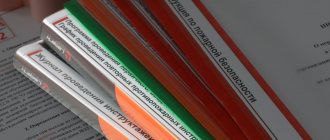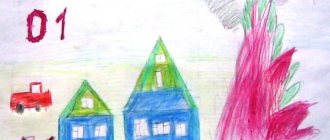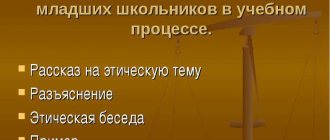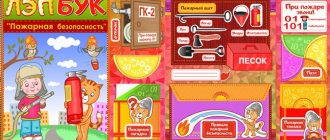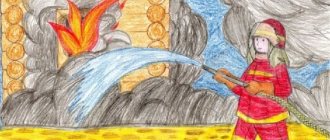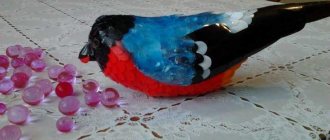Learn fire safety rules
Action plan for children of senior preschool age.
Our little fidgets are in a hurry to explore the world, not realizing the danger that it can bring. And we, adults, cannot always be there to help. That is why it is necessary to develop in children a conscious and responsible attitude towards personal safety and the safety of others. And in this sense, it is very important to introduce them to fire safety rules before school.
Every year we conduct a series of safety events in our kindergarten, the purpose of which is to develop in children the skills of careful handling of fire and an understanding of the need to comply with fire safety rules.
Tasks
- Give children initial information about the causes of a fire.
- Introduce the properties and qualities of objects in terms of their fire hazard.
- Give an idea of the work of firefighters and their professional actions.
- Teach children the rules of safe behavior in the event of a fire: be able to navigate the space of a group room, apartment, know the first actions in the event of a fire, be able to call the rescue service “01”.
- Develop a cautious attitude towards objects that are high sources of fire hazard.
- Foster respect for the firefighting profession.
- Foster a desire to provide mutual assistance and take care of your life and health.
The formation of the foundations of children’s life safety is carried out in different directions, the main ones being work with children, parents, teaching staff and staff. It is important not only to protect the child from danger, but also to prepare him to face possible difficulties, to form an understanding of the most dangerous situations, the need to take precautions, and to instill in him the skills of safe behavior in everyday life together with his parents, who act as role models for the child.
April
I. Methodological work
1. Work with children.
A. Organized educational activities:
- Reading fiction. Cognition. Safety. Communication. Reading the poem by S. Marshak “The Story of an Unknown Hero.”
- Cognition. Safety. Communication. Conversation “Why does a fire occur?”
- Cognition. Safety. Communication. Conversation “If there is a fire in the house.”
- Cognition. Work. Safety. Communication. Conversation “Firefighter is a heroic profession.”
- Cognition. Work. Communication. Excursion to the fire station. Introducing the fire truck.
- Artistic creativity. Cognition. Reading fiction. Safety. Communication. Drawing based on impressions from the work read and from the excursion. X Reading fiction. Cognition. Safety. Communication. Reading the work of S. Marshak “Cat’s House”.
- Work. Cognition. Socialization. Reading fiction. Communication. Joint activities with the teacher. Making masks for the dramatization game “Cat House”.
B. Independent activities of children:
- Physical Culture. Socialization. Health. Outdoor game “Who is faster?”
- Socialization. Cognition. Safety. Communication. Didactic game “Objects are sources of fire.”
- Socialization. Cognition. Safety. Communication. Role-playing game “We are firefighters.”
- Cognition. Socialization. Safety. Communication. Didactic game “What does a firefighter need?”
B. Cultural and leisure activities:
- An evening of entertainment. Cognition. Reading fiction. Safety. Communication. Dramatization game "Cat's House".
- An evening of entertainment. Cognition. Safety. Communication. Quiz "Fire is the enemy."
- Artistic creativity. Cognition. Safety. Communication. Drawing. Exhibition of children's works "Fire: friend or foe?"
2. Interaction with personnel.
- Thematic exhibition “Introducing fire safety rules to preschoolers.”
- Instruction “Protecting the life and health of children.” X Design of the “Service 01” stand.
II. Interaction with parents
- Consultation: “Personal safety of the child.”
May
I. Methodological work
1. Work with children.
A. Organized educational activities:
- Reading fiction. Cognition. Safety. Communication. Reading of E. Khorinsky’s poem “The Little Match.”
- Cognition. Safety. Socialization. Music. Reading fiction. Communication. “Matches are not for playing.”
- Cognition. Safety. Communication. Excursion to the laundry. Introduction to the operation of an electric iron.
- Cognition. Safety. Socialization. Reading fiction. Communication. “Don’t dry your pants over the gas after washing, otherwise your pants will leave holes!”
- Cognition. Safety. Communication. Conversation “So that there is no fire.”
- Cognition. Safety. Communication. Conversation “If there is a fire in the house. Phone 01.”
- Safety. Cognition. Socialization. Communication. Training games to develop children's safe behavior skills.
B. Independent activities of children:
- Safety. Cognition. Socialization. Communication. Didactic game “It burns - it doesn’t burn.”
- Physical Culture. Health. Socialization. Outdoor game "Fast and dexterous."
- Safety. Cognition. Socialization. Communication. Didactic game “What can’t be done in the absence of adults?”
- Socialization. Cognition. Safety. Communication. Role-playing game “We are firefighters.”
- Safety. Cognition. Socialization. Communication. Didactic game “In the world of dangerous objects.”
- Socialization. Cognition. Safety. Health. Communication. Role-playing game “Hospital” (providing first aid to a fire victim).
B. Cultural and leisure activities:
- Artistic creativity. Cognition. Safety. Communication. Drawing. Children's drawing competition "Fire is a friend, fire is an enemy."
- An evening of entertainment. Cognition. Safety. Communication. Quiz “Take care of your house from fire!”
2. Interaction with personnel.
- Thematic exhibition “Fire Safety”.
- Organization of a practical lesson “Evacuation of children in case of fire.”
II. Interaction with parents
- Consultation: “Rules of conduct and actions in fire conditions.”
- Design of a thematic exhibition (from joint works of students, parents and teachers) “Take care of nature from fire!”
Lidiya Glazkova, senior teacher at MBDOU
“Kindergarten for general developmental type “Vasilyok”,r.p. Mullovka, Melekessky district, Ulyanovsk region
Instructions for fire safety in preschool educational institutions
Basic instructions on fire safety measures in preschool educational institutions, fire safety instructions for administration, employees, procedures for action in case of fire, etc. are presented.
The head of the kindergarten is responsible for fire safety and fire protection in the preschool educational institution. He may, by order, appoint a person responsible for fire safety in the institution. It is mandatory that those in charge must develop instructions on fire safety measures in preschool educational institutions (kindergarten), as well as in warehouses, in the catering department, in the sports and music halls. download: Documentation on Fire Safety in Preschool Educational Institutions 38 documents taking into account laws as of September 8, 2022!
- Instructions on fire safety measures in preschool educational institutions
- Instructions on fire safety measures in the catering department of preschool educational institutions
- Instructions on fire safety measures in a food warehouse in a preschool educational institution
- Instructions on fire safety measures in the warehouse of inventory and goods and materials in preschool educational institutions
- Instructions on fire safety measures in the laundry room of a preschool educational institution
- Job description for fire safety of the head of a preschool educational institution
- Job description of the person responsible for fire safety
- Fire safety instructions for the duty administrator of a preschool educational institution
download: Regulations for preschool educational institutions 84 regulations in a package or individually. Update date: 10/06/2021
It is very important to bring to the knowledge of all kindergarten employees the provisions of the instructions on the procedure for maintaining and bringing the premises of the preschool educational institution to a fire-safe condition in order to prevent fires in classrooms and flooding.
Extracurricular activities
Teachers at extracurricular activities in elementary schools can show students how to prevent accidents at home or school. It is much easier for children to remember all the warnings and rules while playing.
- Quizzes
The advantages of quizzes, questionnaires and riddles are that they are quite easy to create yourself, and you can come up with any design for them. You can cover different topics:
- fire safety rules in the apartment;
- rules for handling electrical appliances;
- how children should behave in case of fire;
- how to eliminate a fire indoors or outdoors;
- Forest fires;
- firefighter profession.
It will be especially interesting to present everything in an allegorical form. You can use images of your favorite cartoon characters. For example, “How Dunno Decided to Become a Fireman” or “The ABCs of Fire Safety,” where mischievous Smeshariki, Fixiki and other fairy-tale and cartoon characters will tell schoolchildren how to properly extinguish electrical fires and how to behave in a burning apartment.
The quiz can be designed as an interactive presentation: children will participate in the adventures of the heroes and answer questions asked by them or the teacher . You can supplement the game with riddles, music or cartoon footage. This option will definitely appeal to children and has many options for implementation.
There is another type of quiz design. Several students can participate in the performance by asking questions and riddles to their classmates. There are also many options for heroes and themes: you can play yourself (schoolchildren) or characters from fairy tales and cartoons (here you will need costumes or masks). You can supplement the quiz with a presentation and music.
A competitive form of quiz will help develop interest in the event. For the correct answer to a question or riddle, the student is given a token (can be made of cardboard) of any shape, for example, a fireman’s helmet or a fire extinguisher. And the winner will be awarded with a themed poster, a treat or a cardboard medal.
- Conversations
Conversations are the most informative form of event to provide knowledge of fire safety. A teacher or invited specialist will give a lecture on the rules of proper behavior with fire. Another advantage of this form of event is the opportunity for schoolchildren to ask questions that interest them.
The topic of the speech can be anything. It is better to start a conversation with younger schoolchildren with a short story about the development of firefighting in Russia, and then move on to the safety rules themselves in case of fire in a school, in an apartment or in the forest.
It is quite difficult for elementary school students to fully consolidate information received only from hearing. To make memorization easier, a teacher or specialist can prepare a presentation with illustrations and a summary of what was said. You can also use chalk and a blackboard, drawing and writing down what is needed.
Posters and drawings on paper will attract children's attention. To memorize the material, you can use educational films, cartoons and video materials that complement and reinforce the information told.
It will be very interesting for children if the structure of some things and rules are shown in real objects. Bringing a fireman's helmet, a fire extinguisher, building models - everything will attract the attention of younger schoolchildren, who will be able to better remember the material.
- Games
Perhaps games and sporting events are the most fun and interesting type of fire safety training event. They can be held on Russian Fire Service Day, celebrated on April 30.
At the sports festival, the presenter, together with a guest hero (a character from a cartoon fairy tale or a fireman), will test the agility, courage and speed of younger schoolchildren. The following competitions can be held:
- “fire truck relay”: participants take turns getting on small cars or scooters, then speeding to the turn, and then returning to the others. The first team to complete the challenge wins;
- “pet rescue”: a relay race that includes several types of obstacles (tunnel, bumps, mat), after overcoming which the participant must take a toy animal and return to the team;
- “put out the fire” competition: this test tests the accuracy and dexterity of schoolchildren. While sitting and standing, participants take turns throwing balls (water droplets or sandbags) into the fire basket. The team that hits the most times wins;
- “firefighter call”: team members will have to get through obstacles (hoops, bumps, skittles), then run to the phone and shout “01 – FIRE!” and pass the baton;
- “pass the sandbags”: the teams line up. First, the ball (“sandbag”) is passed between the hands and then under the feet.
After competitions and competitions, you can arrange a display of chants and team mottos. Then – summing up and awarding the winners.
- Creative exhibitions
Primary school children can be introduced to fire safety rules through creativity. The teacher will offer to do any craft that explains the danger of fire.
It could be a poster, a drawing, a craft made from natural and available materials, embroidery, a toy, a cardboard house, a car, a tree, etc. You can create a themed crossword puzzle. Students will be interested in getting acquainted with the exhibits of the organized exhibition.
Don't joke with fire, so you don't regret it later!
Contained in sections:
- Safety, life safety. Lesson notes 4287
- Fire safety 7529
Includes sections:
- Fire in the forest. Protecting the forest from fire 161
By groups:
- Senior group
- Preparatory group
- Middle group
- Junior group
Showing publications 1-10 of 2508. All sections | Fire safety. Class notes
New
Photo
The best
Summary of a lesson on developing safe behavior skills in the senior group “Rescue Service” Teacher: Otarova Lusena Khazhberdovna Author of the program: “From birth to school”
N. E. Veraksa, T. S. Komarova, M. A. Vasilyeva Group, age: senior group, 5-6 years Type of
lesson : integrated (cognitive and speech development)
Purpose: Expanding children’s ideas about practical...
Role-playing game in the senior speech therapy group “Rescue Service” Role-playing game in the senior speech therapy group “Rescue Service” Teacher: Ryndina N.A Goal: to expand and consolidate children’s skills and knowledge about the work of the rescue service in the game, about dangers to humans life situations and ways of behavior in them. Objectives: - Strengthen skills...
Fire safety instructions in kindergarten
Officials and employees of a preschool educational institution must clearly know the procedure for action in the event of a fire and evacuation in order to evacuate children in a timely and safe manner, notify the fire service and the head of the preschool educational institution in a timely manner, and take appropriate measures to extinguish the source of fire in the absence of a threat to life.
download: Job descriptions for preschool educational institutions (Profstandard) 31 instructions individually and in packages, updated - September 5, 2021!
- Fire safety instructions for preschool employees
- Instructions on the procedure for officials to act in the event of a fire in a preschool educational institution
- Instructions on the actions of personnel during evacuation in case of fire in a preschool educational institution
- Instructions on the procedure for maintaining and bringing premises of preschool educational institutions to a fire-safe condition
- Instructions for fire safety during mass events
- Fire safety instructions for New Year's events
- Fire safety rules for children in preschool educational institutions
- Fire safety rules for children at home
- Procedure for employees to evacuate in the event of a fire at a preschool educational institution
- Instructions on fire safety measures during repair work of preschool educational institutions
- Instructions on fire safety measures when carrying out painting work at preschool educational institutions
- Instructions for fire safety when carrying out hot work at preschool educational institutions
